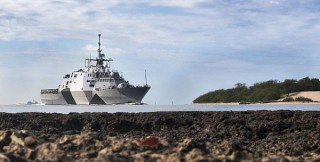
In the next year the Navy will begin competition for the follow on sonar and surface-to-surface missile system for the Anti-Submarine Warfare (ASW) and Surface Warfare (SuW) mission packages of the Littoral Combat Ship, Capt. John Ailes, head of the LCS mission module program for Naval Sea Systems Command said at a briefing at the Navy League Sea Air Space Exposition 2013 at National Harbor, Md.
Currently, the ASW mission package is testing the Thales 2087 sonar. The sonar was a swift replacement following the cancellation of Lockheed Martin’s Remote Multi-Mission Vehicle – (RMMV) for use in the LCS package. The Navy wanted an “in-stride,” capability to allow the ship to scan for submarines at speed. The RMS would have required an LCS to remain on station while the RMMV patrolled for subs.
Ailes said that testing with the Thales 2087, combined with a towed-array, was positive and that the ship could effectively detect and track subs
“We also have a system that is particularly immune to noise,” Ailes said. “That gives us a big advantage so we can go fast. Much faster than the in service fleet is able to and we can still find and prosecute submarines.”
The Navy will also begin competition for the surface-to-surface missile for the SuW package in a year.
“The focus will be on systems that are in production. We don’t have a lot of research and development [money] to develop a new system. Our money is focused on integrating a new system,” Ailes said.
“We took the same launcher that is being used for the patrol craft, modularized it and dropped it into the [LCS] weapon zone.”
The SuW package was originally designed to accommodate the Non-Line-of-Sight missile system (N-LOS) to provide a standoff capability for the LCS at a range of 25 miles. N-LOS was cancelled in 2010. In 2011, the Navy announced it would examine Raytheon’s Griffin missile to test in as part of the package.
In the last month, the Navy has conducted tests with the Griffin on Cyclone-class patrol craft ahead of a competition for a new missile.
Both the ASW sonar and the SuW surface-to-surface missiles have suffered major delays in development over the life of the LCS program.





